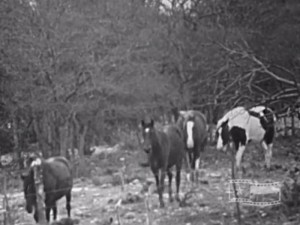
"This amateur film chronicles several young ranchers in their day-to-day activities. The film is divided into six chapters, each highlighting a different theme. Setting the scene with shots of a river bend and surrounding cliffs, the movie shows two young men skipping stones by a creek. After playing around with rocks and a rope swing, they drive back to 141 Ranch. At the ranch, they take care of their cattle and spend quality time grooming and riding their horses. The last chapter introduces a strange boy, who startles one of the ranchers as he washes a frying pan outside. The film ends with the young men riding their horses towards the camera" Texas Archive of the Moving Image.
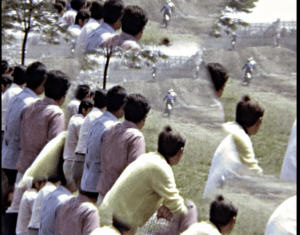
El filme comienza con una descripción de como iniciar en el Cross. Vemos un campeonato de Cross desarrollarse en los alrededores de Álava y la premiación a los
ganadores. Un joven se ilusiona por ser corredor de Cross.
The film begins with a description on how to begin cross country running. Then a cross-country championship is seen developing in the surroundings of Alava, and then we see the awards ceremony for the winners. A young man is seen getting excited about becoming a cross country runner.
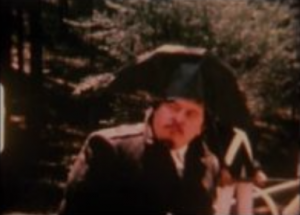
"Se trataba del regreso de un soldado de origen mexicano a la Ciudad de México después de haber combatido en Vietnam con las tropas estadounidenses. El hombre llega a la estación del ferrocarril de Buenavista y recorre la ciudad para acabar finalmente en el departamento de su hermano. Busca trabajo y no lo encuentra. Por la voz off que sigue el hilo de sus pensamientos, nos enteramos que a su mente guerrera le cuesta trabajo adaptarse a la vida pacífica. La película intercala una serie de secuencias oníricas que de alguna manera ilustran su delirio belicista: sueña que es un soldado griego que asesina al niño que lo molesta en el taxi colectivo (un pesero) que lo conduce a casa de su hermano; imagina en el personaje que lo entrevista cuando aplica para obtener un trabajo a Napoleón Bonaparte (interpretado por Juan José Gurrola) dirigiendo una batalla; o sueña que es un caballero medieval que asesina a su familia en un pacífico día de campo. Finalmente el personaje no encuentra cabida en la sociedad pacífica y acude –todavía en traje de caballero medieval – al aeropuerto para comprar un boleto de avión "a la guerra más próxima"" (Vázquez Mantecón, 2012).
"It is about the comeback of a Mexican soldier to Mexico City after fighting in Vietnam along with American troops. The man arrives to the train station in Buenavista y goes around the city to end up at his brother's apartment. He looks for a job and cannot find one. The off voice, that follows his train of thought, tells us that his war mind has trouble adapting to a peaceful life. The film inserts a series of dreamlike sequences that in a way illustrate his war delirium: he dreams he is a greek soldier that murders the kid that bothers him in a collective cab that drives him to his brother's house; he imagines the character that interviews him when he is looking for a job is Napoleon Bonaparte (played by Juan José Gurrola) directing a battle: or he dreams he is a medieval knight that murders his family in a peaceful day in the country. Finally the character doesn't find a place in a peaceful society and goes –still in medieval armor– to the airport to buy a by a plane ticket to the "nearest war" " (Vázquez Mantecón, 2012).
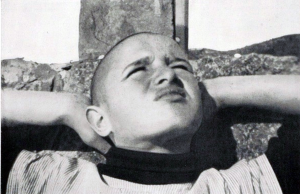
"a soggetto lungho normale"/Fiction feature film
"Arco felice, realizzato da Domenico Paolella: collaborazione generale di Remigio del Grosso. È’tra i film a soggetto, a formato ridotto, quello che più di tutti gli altri tiene conto della importanza dello scenario - montaggio, della continuity per dirla con una precisa espressione. Infatti la continuità narrativa e visiva e mantenuta costante e precisa dal principio alla fine, in unione ad una singolare efficacia descrittiva, piuttosto sintetica dell'ambiente e dei tipi: sono questi ragazzi della strada e del porto, gli scugnizzi napoletani, di cui il film si propone di mostrare la rigenerazione, compiuta attraverso la organizzazione dei ragazzi nelle colonie permanenti dell'Opera Nazionale Balilla. La dimostrazione e assolutamente priva di ogni elemento retorico e il racconto non ha incertezze; assolutamente senza didascalie, il film non richiederebbe nemmeno il parlato, tanto gli autori si sono preoccupati di rendere tutto attraverso immagini, in un procedere di andante mosso che ben si addice al tema del film. Sopratutto e chiaramente espresso il contrasto tra uno dei ragazzi e gli altri; questi ormai nella via della rigenerazione, quello invece ancora perplesso e scontroso di fronte alla nuova vita· i due motivi sono seguiti parallelamente secondo il sistema caro ai suoi tempi a Griffith, col mostrare i ragazzi inquadrati nelle loro diverse attività, in una gita, e l'altro solo di fronte al mare; il ragazzo fugge ne alcuno lo richiama; ma quando si trova nel porto, una assordante confusione lo invade ed egli ritorna alla colonia al momento dell'ammaina bandiera. Forse in quest'ultima sequenza il film riesce un po' sbrigativo; ma tuttavia anche qui come nel resto si avverte la freschezza e la sincerità della narrazione e delle espressioni degli interpreti scelti dai realizzatori tra gli stessi ragazzi di una colonia."
"Arco felice, directed by Domenico Paolella: general collaboration by Remigio del Grosso. More than any other small format fiction film, it takes into account the importance of the relationship between screenplay and the montage, of the continuity, to use a precise expression. In fact, the narrative and visual continuity is kept constant and precise from the beginning to the end, together with an original rather concise description of the environment and characters: these boys of the street and of the port, the Neapolitan street urchins, of which the film proposes to show the rehabilitation, accomplished through the organization of the boys in the permanent camps of the Opera Nazionale Balilla, The development is absolutely devoid of any rhetorical element and the story has no ambiguities; absolutely without inter-titles, the film would not even require sound, to such an extent have the authors have taken care to render everything through images, in a proceeding of a moving andante that well suits the theme of the film. Above all, the contrast between one of the boys and the others is clearly expressed; the latter are now on the road to rehabilitation, while the former is still perplexed and surly in the face of his new life. The two motifs are followed in parallel according to the system dear to Griffith in his day, showing the boys framed in their various activities while on an excursion, and the other alone in front of the sea; the boy runs away and no one calls him back, but when he finds himself in the port, a deafening confusion invades him and he returns to the colony at the moment of the lowering of the flag. Perhaps in this last sequence the film is a bit hasty, but here, as in the rest, you can feel the freshness and sincerity of the narrative and the expressions of the interpreters chosen by the makers among the same boys of a camp."
—Il ventuno 28 (Review of the G.U.F. of Venice), May 1935, p. 16
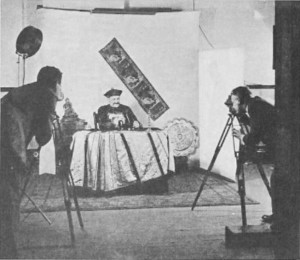
Promotes the all-round activities of YMCA work and their relationship to character-building. Kenyon, a one-time YMCA athlete, has "fallen into evil companionship" and become addicted to cocaine. Under the control of Chinese underworld kingpin Chang Yat, he aids in the kidnapping of a white girl. Afterwards, he discovers his old "Y" pin and recalls the role of YMCA athletics in shaping his character. Seized with remorse, he overpowers Chang Yat and helps the girl escape. Later, Kenyon returns to the YMCA. (D.J. Duffy, condensed from "Y.M.C.A. Cinema Club Produces Smart Film," Toronto Daily Star, May 31, 1930, p. 30.)
Film was sponsored or co-produced by the Central Y.M.C.A. of Toronto, and written by the club's secretary, H.G. McKinley.
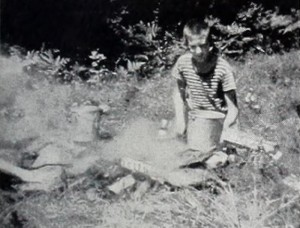
"Excellent films have been made that show by more or less indirection what adults believe boys should do in camp. But what would boys like to do? Henry E. Hird, in The Big Adventure, seems almost to have thought with a boy's mind — a very real accomplishment for a busy executive — in producing this dramatic tale of boys in the woods. Two youngsters of about twelve years, armed with bows and arrows, are taken by their father on an island camping trip. Resigned, as most boys are under the instruction of their elders, they watch Father show them camp life in detail — and how he enjoys it! Suddenly he leaves for a war conference in Washington, and the two adventurers are alone for the night. A tramp appears, captures them, is outwitted by them and is seized by a helpful farmer. To bed and fears of invading bears go our heroes — when Dad returns, the conference deferred. It is a safe bet that young boys will approve Mr. Hird's dramatic movie as more realistic than some of the "approved solutions" offered to youthful campers." Movie Makers, Dec. 1945, 496.
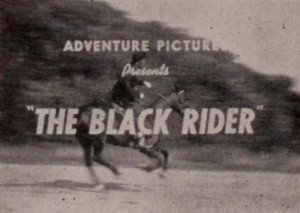
"For Louis McMahon, making movies must seem to be as natural as breathing — only far more fun. It stands out in his work, from the first dynamic opening of The Black Rider to the last dramatic gun fight, in which, inevitably, the villain is vanquished and the hero left triumphant. For this film goes back to first principles of the motion picture, both in its "horse opera" subject matter and in its unfailing sense of movement and compelling excitement. True to the old traditions, this young producer has turned seemingly impossible obstacles with cinematic trickery and imagination. For the present, his technical skill has not always been equal to his creative ambition, but the genuine urge is there in abundance." Movie Makers, Dec. 1941, 566-567.
"A tale of a misguided farm boy who gets into trouble trying to get his girl in the big city." Minnesota Historical Society.
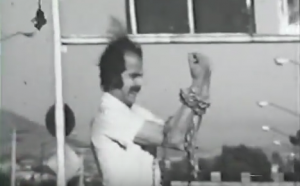
"A successful man living in a great metropolis is increasing awareness of the unjust social reality that lives in the absurdity. This immerses him in a uneasiness that sinks into alcoholism and depression. In his wandering through the streets viewer gets to be the unfortunate suicide of another victim of the meaninglessness of life, which will produce a series of dreamlike hallucinations bordering on the madness. In a stroke of consciousness of his misfortune, he does run aimlessly without course. Devastated, to the dawn, with the light of the dawn he sees to be reborn the hope personified in an innocent girl who stretches the hand donating bread" Internet Archive.
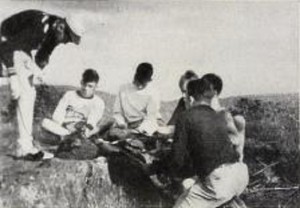
"The fact that the film, Camp Pinnacle, made by Robert F. Gowen, was provided with a clear spoken accompaniment served to enhance the workmanlike excellence of its cinematic presentation. Since it was a film made, avowedly, to sell to prospect parents the advantages of Camp Pinnacle, it would hardly have been fair to look for those more delicate nuances of atmosphere and sequence which may become a labor of love in the more personal film. Thus Camp Pinnacle was chosen for its excellence as a straightforward exposition, in glowing color, of every interesting aspect of the lives of the lads and their counselors at camp. In setting this forth, Mr. Gowen has chosen simple, natural sequences and has interpreted these with technical excellence and secure knowledge of the Kodachrome medium." Movie Makers, Dec. 1936, 551.
Total Pages: 4